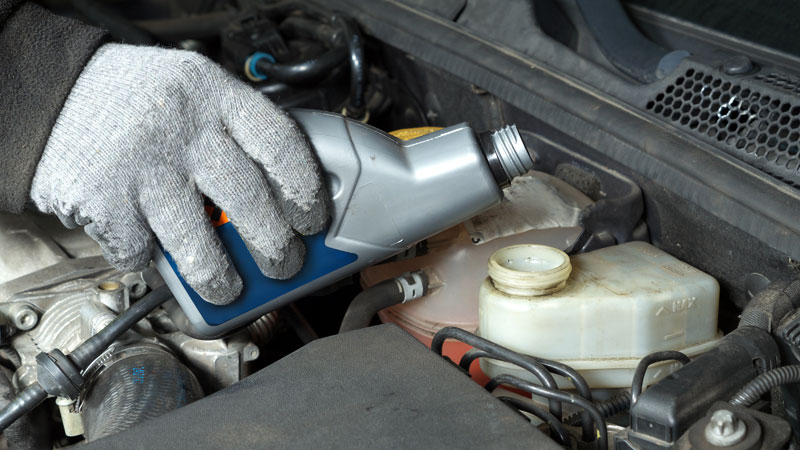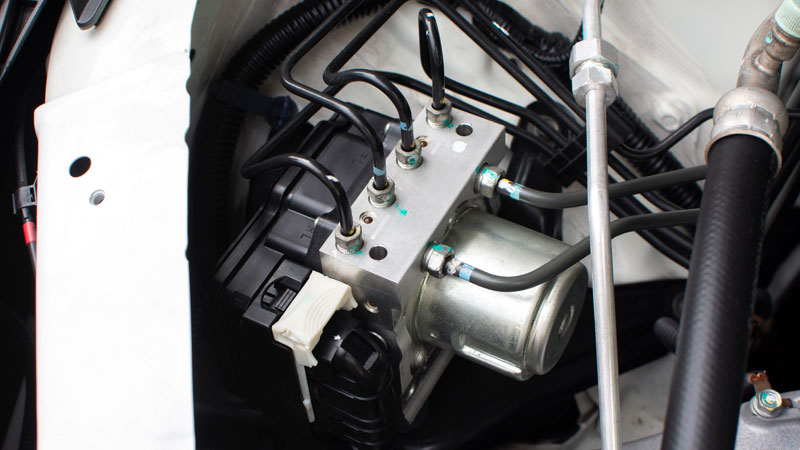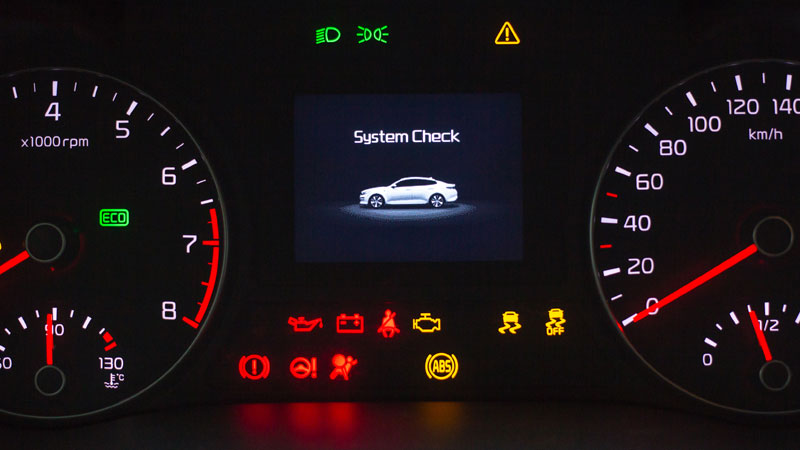

Modern vehicles have what is known as an anti-lock braking system. The purpose of this system is to keep the driver safe by preventing the wheels from locking up as you apply the brakes. That way, you can keep control over the steering and your vehicle won’t skid as a result of the wheels locking up.
In addition, there is a warning light on the dashboard which will illuminate if there is any sort of problem with the anti-lock braking system. This is a light that you need to take seriously because it is an early warning sign that your braking system needs to be inspected right away.
Table of Contents
“ABS” stands for anti-lock braking system. When you step on the brakes hard, you are likely to lose traction on one or more tires. This is called lock-up. Tire lock-up happens when the friction between the brake pad and the brake rotor is greater than the friction between the tire and the road surface.
When your tires are spinning, you have better control over the car. You will also typically experience a shorter stopping distance. This is because a rolling tire has more grip than a sliding tire. The ABS system is designed to grab and release the brakes very rapidly at all four corners to prevent tire lock-up and keep each tire spinning, while still allowing you to slow the vehicle as quickly as possible.
There are many causes which could make an ABS light come on. It doesn’t always mean there is a problem with the anti-lock braking system directly. There could also be a problem with other sensors or components that it communicates with as well.
Below are the top 6 causes of an ABS light coming on.

The brake fluid has a lot to do with controlling the braking pressure within an anti-lock braking system. There is a brake fluid reservoir which holds the fluid of the anti-lock braking system.
Sometimes there could be a leak from this reservoir which will cause the fluid levels to drop. Either that or excessive amounts of air may exist within the system.
Either way, it may certainly cause the ABS warning light to illuminate on the dashboard.

There are speed sensors built into every wheel’s hub which calculate the movement rate of that wheel. This information then gets transmitted to the anti-lock braking system.
If it turns out that at least one of the wheels is moving too slowly, the anti-lock braking system will increase the pressure of the brake fluid to allow the wheel to move at a normal speed.
But if there is a problem with the speed sensor, the anti-lock braking system will detect that and cause the warning light to illuminate on the dashboard.

The module of the anti-lock braking system can form corrosion after a while. This is actually one of the most common reasons for why there ends up being a problem with the anti-lock braking system.
If the module is corroded, then it can’t obtain information from the wheel speed sensor. As a result, the ABS light illuminates on the dashboard. It doesn’t even take a lot of corrosion to cause this to happen either. But you will need to replace the module after this happens.

Some vehicles will perform what is known as a bulb check on the dashboard. This check is for the driver’s convenience, so they know the bulbs of their vehicle’s warning lights are working properly.
These lights will usually turn off by themselves after a certain amount of time. In some instances, there may be a glitch in the bulb check which keeps the ABS warning light illuminated after the bulb check is completed.

If there is one wheel of a vehicle that moves at a different speed than the other wheels, the wheel speed sensor detects this and then notifies the anti-lock braking system.
Once this happens, the system will activate the hydraulic pump to increase the amount of brake fluid pressure. This will allow the wheels to maintain their traction as they’re touching the ground.
Unfortunately, hydraulic pumps tend to get worn out after years of using them. This would certainly cause the ABS light to come on, which means you’d need to replace the pump right away.
Fuses are often overlooked components in your car’s electrical system. They protect your car’s electrical circuits by breaking the circuit when there’s too much current flow. Because of this, they’re a possible cause of your ABS light illuminating.
To check if it’s a blown fuse causing the problem, you can locate your car’s fuse box which is usually found under the hood or near the driver’s side dashboard. Look at the fuses related to the ABS system and see if any of them have a visibly broken wire or cloudy appearance inside the glass. Replace any blown fuses with new ones to see if the ABS light turns off.
The moment an ABS warning comes on, you need to focus on safely decelerating your vehicle. When possible, calmly steer towards a safe pull-off spot or wide shoulder area bringing your speed down in a controlled manner.
Hazards lights can help alert following traffic that you are exiting the flow until the issue is addressed. Avoid sudden, hard braking that could send wheels into a skid without ABS functioning. Utilize smooth pumping of the pedal instead, allowing wheels to slow speed between pumps.
Once fully stopped in a secure spot, shift into park and evaluate if brakes feel soft or continue pressure build up normally. Moving out of traffic removes risk if ABS electrical faults impact traction, stability or core brake performance.
When the ABS light turns on, other alerts often illuminate indicating issues beyond just the anti-lock brakes. The brake warning and ABS symbols coming on together typically signals low brake fluid or worn pads.
A check engine notification points to electrical faults tied to ABS module. Traction control and stability alerts reference compromised systems connected to ABS as well. Scanning the full instrument cluster helps diagnose root causes before repairs.
Drivers should also gently test pedal pressure for changes from typical braking sensation and listen for odd ABS mechanical sounds. Cross-referencing visual dashboard warnings with any noticeable physical symptoms provides direction on where to start investigating ABS electrical and hydraulic processes when problems arise.
Once pulled over and identifying any related warning lights, you’ll want to evaluate any physical symptoms accompanying the alert before proceeding to a shop.
Apply the brakes gently while at low speeds listening for unusual mechanical noises coming from the wheel wells or undercarriage. Grinding, excessive spinning or whirring sounds can signify issues like worn ABS sensors or internal valve or pump failures.
Also assess brake pedal sensation – does it feel abnormally soft or sink closer to the floor compared to normal? Check brake fluid level if pedal is spongy. Significantly reduced or loss of pedal pressure likely signals fluid leaks or hydraulic problems tied to ABS.
Document auditory signs of damage plus brake pedal anomalies to share with your technician. Detecting physical symptoms linked to the ABS light delivers clues on fault origins to the repair diagnostic. This maximizes efficiency in pinpointing root causes.
Your next step would be connecting an OBD-II scan tool to access any diagnostic trouble codes (DTCs) that may have been stored. ABS systems have extensive fault code libraries – by plugging a scan device into the data port and reading ABS-specific codes, you can research the flagged issues before a technician visit.
For example, a right front wheel speed sensor DTC helps narrow diagnosis down to that corner rather than guessing. Professional diagnostic computers offer more advanced testing capabilities, but a simple OBD2 scanner and DTC research gives drivers better context on where ABS electrical gremlins reside.
This ultimately reduces guesswork and speeds up troubleshooting processes later during shop visits. Jot down and codes from your personal scanner for easy reference discussing symptoms.
With key diagnostic information gathered at the scene of the ABS warning illumination, the next move is schedule an appointment at a local auto repair facility or dealership for professional service. Book a timely visit even if dashboard lights disappear – root causes like leaks stay problematic without correction. Service after ABS activation reduces risk of reoccurrence or escalation over time.
Just because your ABS light is on, that doesn’t mean you can’t drive your vehicle. In fact, you will still be able to step on the brake pedal and slow the vehicle down.
However, your ability to perform a panic stop will be limited as you run the risk of locking the tires under heavy braking. Locking the tires increases stopping distance dramatically and prevents you from steering until the front tires regain traction.
What you need to do is drive carefully to the nearest mechanic after the ABS light comes on. Brake slowly when necessary but avoid braking quickly or aggressively. If you can do that, then everything will be fine.
The only circumstance where you shouldn’t even attempt to drive your vehicle is if the brake system light comes on when the ABS light is on. The brake system light indicates a much bigger issue with your braking system — a problem which may limit your ability to brake the vehicle at all. Therefore, you would need your vehicle towed to the mechanic if you notice both lights on.
Most of the time, your ABS light will turn off automatically once the issue is resolved. If it does not, you should be able to use an automotive scan tool to delete the stored code and turn off the ABS light.
That said, if the root issue has not been resolved, the ABS light is likely to return in the near future.
The most common culprit is a wheel speed sensor getting disrupted by road debris, dirt, or moisture. This interference can lead to inaccurate readings, causing the ABS system to get erratic signals and illuminate the warning light sporadically.
Loose or corroded wiring connections related to the ABS system can also be responsible. Bad connections can create short-term problems that make the light flick on and off inconsistently. Inspect the ABS wiring for any damaged connectors and repair or clean them as needed.
Worn brake pads don’t directly cause the ABS light to turn on. However, they can indirectly trigger it.
As pads wear down, brake calipers need more fluid to maintain pressure. This can lead to low brake fluid levels, setting off the ABS light. So if you notice worn pads, check and top up brake fluid. Replacing the pads will also prevent further problems.
Kevin has been fascinated by anything automotive since his first go-kart as a kid to his time working as an auto tech for Dodge after obtaining his degree in automotive technology. When he's not working on cars or writing about them, you can find him and his E36 M3 at an event with the local chapter of the BMW CCA.
Latest posts by Kevin (see all)